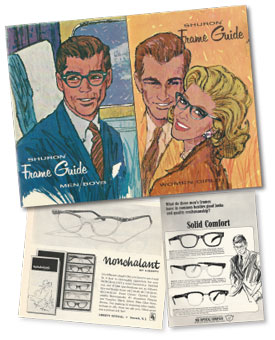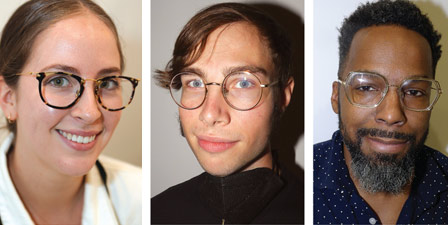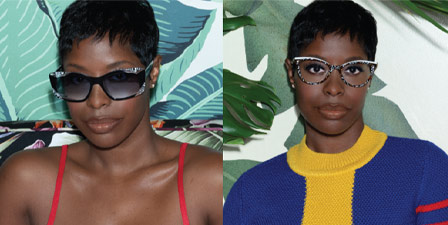
By Preston Fassel
 The brow is back.
The brow is back.
After nearly a half century relegated to the Medicaid box, the faces of cinematic nerds and the back of your grandmother’s closet, the frame style that once defined an entire era is finally retaking its rightful place in the pantheon of cool: Browlines.
You may refer to them as clubmans, clubmasters, combinations or any other variety of “c” words… but when Shuron Optical invented them in 1947, they were dubbed Browlines, and within 13 years this particular style accounted for half the eyeglasses being worn in America and especially so on men. It was a feat that no other single style has been able to replicate, before or since. The design was a perfect emblem of America’s cautious, postwar optimism and reemergence as a global power player, a melding of the metals of yesteryear with the plastics of tomorrow. From Vince Lombardi to Eleanor Roosevelt, Lyndon Johnson to Malcolm X, Colonel Sanders to Frank Zamboni, the appeal of browlines crossed every border of race, religion and socioeconomic status, instantly identifying the wearer as a reckon-izable force.
 Emerging hot on the heels of an age when frame styles were limited to round or oval with rimless delivering the educated guess and wire frames decidedly dominant, browlines broke the mold in every way, ushering in the modern eyewear era’s first fashion war as a variety of competing manufacturers replicated the design to stake out their own piece of the eye-pie. Even when solid zyls began to rise in prominence in the 1960s, aficionados would not be denied the style they loved, and plastic browlines appeared in the form of plastic frames with solid tops and transparent bottoms via the “fade” technique in order to emulate the beloved brow beater.
Emerging hot on the heels of an age when frame styles were limited to round or oval with rimless delivering the educated guess and wire frames decidedly dominant, browlines broke the mold in every way, ushering in the modern eyewear era’s first fashion war as a variety of competing manufacturers replicated the design to stake out their own piece of the eye-pie. Even when solid zyls began to rise in prominence in the 1960s, aficionados would not be denied the style they loved, and plastic browlines appeared in the form of plastic frames with solid tops and transparent bottoms via the “fade” technique in order to emulate the beloved brow beater.
When the countercultural revolution of the ’60s hit, it meant everything old had to go, and browlines became a fashion casualty of changing times. Their omnipresence in the ’50s led to their becoming emblematic of a straightlaced, conformist era, and from nearly Woodstock on the brow became the symbol of someone severely behind the times. Once regarded as hip, innovative, even—dare I say it—dangerous (just dig Burt Lancaster’s bespectacled brute in the classic “Sweet Smell of Success” for a taste of browline badness), browlines were unjustly saddled with a variety of new, less than enviable connotations. Nerdy. Outdated. Irrelevant. Though it premiered in 1993, the film “Falling Down” put the final nail in the once noble frame’s coffin, as Michael Douglas’ deranged engineer redefined browlines for Gen Xers as the frame choice of the “angry white male.”
The style was too powerful to stay dormant and so ill-defined, though its allure too pure. Browlines had safely navigated the ’80s in the form of sunglasses, brought to prominence by Bruce Willis on “Moonlighting” and kept afloat by Ray-Ban’s Clubmasters; and while other manufacturers began to shut down their browline production and look to the future, Shuron held true to its roots, continuing to manufacture the frame in anticipation of the day that the browline would return to prominence.
That day is today.
While retro-cool is clearly here to stay, the days of bulky black zyls are slowly waning, their dusk giving way to a new dawn for the browline. Wanting to replicate a vintage look but not wanting to have their faces dwarfed by knockoff Wayfarers, eyeglass wearers have re-embraced the browline with a ferocious sincerity that has design houses once more struggling over one another to eke out their own niche in the market. Of course, Shuron’s still around; also look for frames by Victory Optical, one of the original browline innovators of the ’50s, who have resurrected their own old designs for a new generation of wearers.
And… anew to the fight are near countless other vendors in the eyewear game: It’s nearly impossible to find a line that doesn’t offer some recreation or variation of the design, from modernized rectangular browlines to sleek, solid metal designs featuring thick steel caps screwed to thin wire bases—a style particularly precious and prevalant in women’s frames. Aiding in the style’s resurrection is a newfound ubiquity in the film and television of the past decade: From Matt Damon’s sinister CIA agent in 2006’s “The Good Shepherd” to the tech-savvy new Q of 2012’s “Skyfall” to television genius Harry Crane of “Mad Men,” browlines have re-entered the public consciousness as a symbol of powerful intensity, geeky brilliance and retro fly. And noting villains can be heroes, they also seem to be the frame style of choice for televised serial killers, popping up on the noggins of quietly dignified psychopaths on “CSI,” “American Horror Story” and “Hannibal.”
The phoenix has risen from the ashes; no longer a pariah of the eyewear world, glasses wearers young and old, male and female, can embrace the return of this iconic frame…and celebrate the fact that, this time, it’s here to stay. ■













